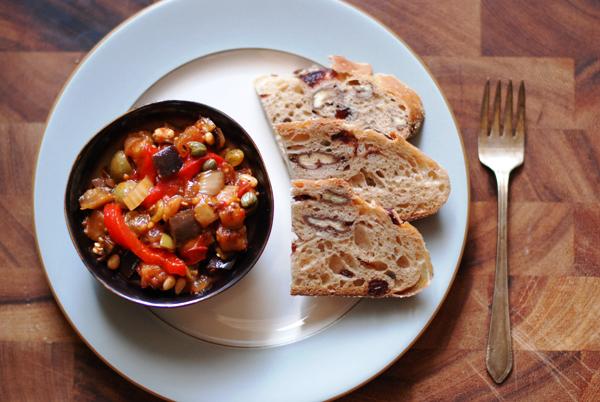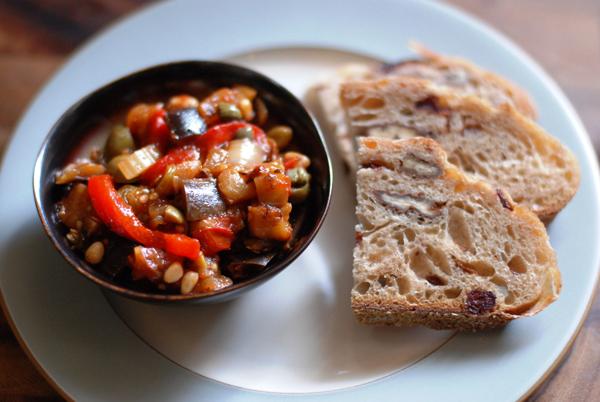Growing up, caponata was a thick, saucy affair. The eggplant was cooked until it almost fell apart, then melted into tomatoes, raisins, olives, and onions until it DID fall apart. Â The result was a dip you could eat alone, but it was even better spread on crackers or sandwiches. I loved that caponata, and I still do.
In college, I encountered caponata anew. My boyfriend at the time had a chef for a dad. Alan was an expert at so many things: his challah recipe was the first one I tried, his salad of perfect Berkley tomatoes sticks with me, and his caponata was the best I’d ever had. Alan made two kinds of caponata. One was redder, with plenty of tomatoes and red wine vinegar. The other was lighter, probably with white wine vinegar and golden raisins.  I’m pretty sure Alan thought about bottling it at one time, and wisely so. Both were excellent.
Not that I’m a stickler for authenticity, Â but I’ve come to learn that none of those caponatas was authentic. True Sicilian caponata is more like a cooked salad. Every component is discernible, cooked carefully so that the flavors are married but not muddled. Caponata, like so much of the best cooking in any region, is about the slow, deliberate layering of complementary flavors. It’s a dish that requires time and patience. With eggplant at the height of their season, I made time last weekend to make it the traditional way.
Eggplant was diced, salted, drained, browned. Mise en place was prepared. Sweet time,  it was taken. Caponata wants to be coddled; the results make the coddling worthwhile.
What you get, after the salting and draining and browning and cooking and adding and heating and finishing, is not unlike a traditional ratatouille. It’s a delicate, precise dish: you can see the cubes of eggplant, the strips of roasted pepper, and the olives (I cheated and used green olives stuffed with pimento, but cerignola would be even better). This is no vegetable mush. We’re getting classy here, people.
Why classy? Well, if you can believe it, this little blog turned 5 last week. That’s something to celebrate, now isn’t it? Over apples and honey cake, I told you about how I want the pace around here to be less frenetic. Even in a weekend full of errands, work, and cooking for lots of people, I made time to coax eggplant into this caponata. While it cooked, we sat with a dear friend, drank her brother’s homemade (award-winning!) beer, and laughed about all sorts of silliness. And you know what? The time alone felt like a celebration. Happy 5th birthday, NDP; here’s to 5 more.
Sicilian Caponata
From Nancy Harmon Jenkins’ Cucina del Sole: A Celebration of Southern Italian Cooking, via Saveur2 eggplants (about 2 lbs.), cut into 1â„2″ cubes
Salt
10 tablespoons extra-virgin olive oil
1 large yellow onion, coarsely chopped
2 anchovy filet, chopped
3 ripe medium tomatoes (about 1 lb.), cored, peeled, and
coarsely chopped
2 ribs celery, diced
1â„4 cup red wine vinegar
2 tablespoons sugar
2 tablespoons tomato paste
2 tablespoons golden raisins
2 tablespoons pine nuts
2 tablespoons capers, rinsed
12 pitted green olives, such as cerignola, coarsely chopped
1 red bell pepper, roasted, peeled, cored, seeded, and thinly sliced
Freshly ground black pepper
2 tablespoons coarsely chopped basil
2 tablespoons coarsely chopped flat-leaf parsley
Put eggplant into a colander set over a large bowl; toss with 1 tbsp. salt. Top with a plate weighted down with several large cans; let drain for 1 hour. Rinse eggplant and pat dry with paper towels. Heat 2 tablespoons oil in a large skillet over medium-high heat. Add one-third of the eggplant and cook until golden brown, 7–8 minutes. Using a slotted spoon, transfer eggplant to a bowl. Repeat with oil and remaining eggplant.
Reduce heat to medium-low and add remaining oil, onions, and anchovies; cook until soft, 14–15 minutes. Add tomatoes and celery and increase heat to medium; cook until tomatoes release their juices, 5–6 minutes.
Add vinegar, sugar, and tomato paste; cook until thickened, 3–4 minutes. Add cooked eggplant, raisins, pine nuts, capers, olives, roasted peppers, and salt and pepper to taste. Cook until hot. Transfer to a plate; let cool slightly. Top with basil and parsley. Serve at room temperature.
Caponata will keep in the fridge for up to 2 weeks.






Comments on this entry are closed.
I love eggplant! And this looks decidedly healthier than what I normally do with it which is hide it inside a moussaka!
And happy 5th blogiversary!
Thanks, Brooke! It certainly is healthier than moussaka; I’d argue it’s more delicious, too.
Congrats on the 5 years, that’s so exciting! I’m hitting 2 and can’t believe you’ve been doing it this long. =)
Happy blog bday, Rivka! I love your writing & recipes.